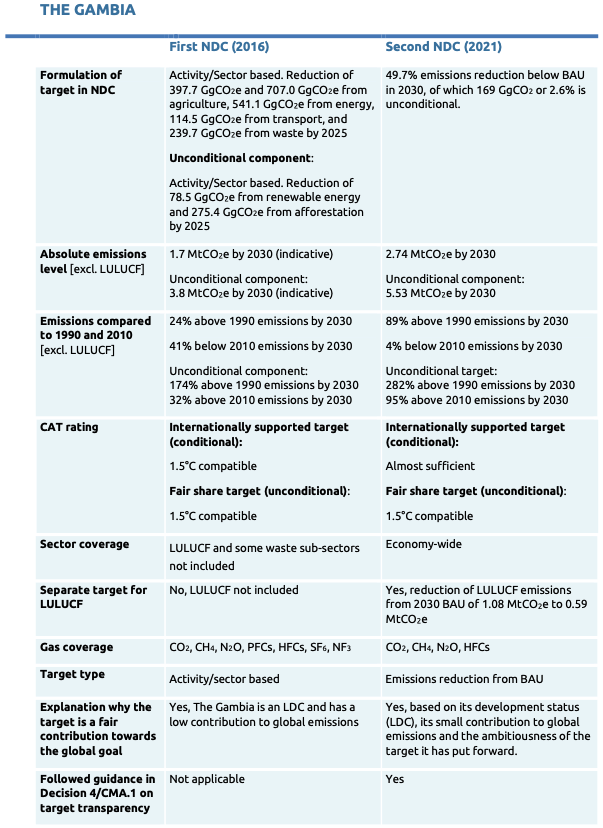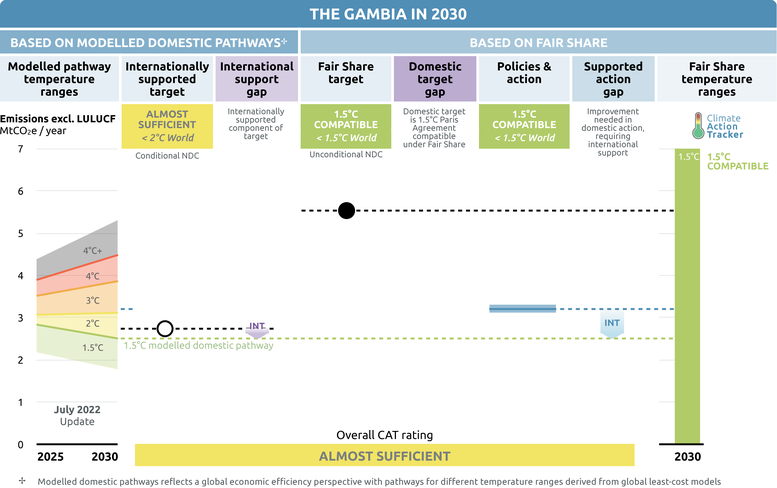Targets
Target Overview
In September 2021, The Gambia submitted its second NDC which set a new target of reducing GHG emission by 49.7% below business as usual scenario in 2030 (incl. LULUCF).
The Gambia has indicated that it will need international support to achieve this target; however, it has indicated that it will undertake two of the mitigation actions proposed to achieve this target using its own resources.
The target equates to a 2030 emission levels of 2.74MtCO2e, once the land sector is excluded.
Almost all of the unconditional elements of the NDC target will be met through the land sector with a small contribution from renewable energy use. We quantify the unconditional portion of the NDC target will result in an emissions level of 5.53MtCO2e in 2030.
The Gambia has a net zero target. It is currently preparing its long-term strategy.

CAT Rating
The CAT rates NDC targets against what a fair contribution to limiting warming to 1.5°C would be, as well as against what needs to happen within a country’s own borders. The Gambia will need international support to achieve the required reductions within its borders.
The Gambia’s NDC target includes a portion that is unconditional, that it will achieve using its own resources. We rate that portion against its fair share contribution (which we refer to as its ‘fair share target’). The full NDC target will require international support to achieve and we rate that against the level of reductions needed within The Gambia’s border (which we refer to as its ‘internationally supported target’).
Further information on how the CAT rates countries (against modelled pathways and fair share) can be found here.
The CAT rates The Gambia’s internationally supported target as “Almost sufficient” against modelled domestic pathways. The “Almost sufficient” rating indicates that The Gambia’s internationally supported target in 2030 is not yet consistent with limiting warming to 1.5°C but could be, with moderate improvements. If all countries were to follow The Gambia’s approach, warming could be held below—but not well below—2°C.
We rate The Gambia’s fair share target as “1.5°C compatible”. The “1.5°C compatible” rating indicates that The Gambia’s fair share target is consistent with limiting warming to 1.5°C. The Gambia’s fair share target does not require other countries to make comparably deeper reductions or greater effort, and is in the most stringent part of its Fair Share range.
The portion of its NDC that The Gambia will achieve unconditionally using its own resources is above our current policy projections for The Gambia, making it unlikely that these actions will drive further emissions reductions.
NDC Updates
While The Gambia’s 2021 NDC is a progression from its 2016 NDC in some ways, such as expanding sector coverage, the update does not lead to lower emissions than the first NDC due to a revision of the BAU scenario.
The total absolute emissions reductions of activities are higher in the updated NDC than in the first. As a result, the CAT’s rating of its NDC (internationally supported target) and overall has fallen from ‘1.5°C compatible’ to ‘Almost sufficient’. The Gambia needs to strengthen its NDC target slightly (from its current 49.7% below BAU to 53.2% below BAU) to return to 1.5°C compatibility.
The Gambia submitted its second NDC in 2021 with revised mitigation targets and additional mitigation measures. It will undertake two mitigation measures in forestry and energy using its own resources. The mitigation potential of these unconditional measures would result in an absolute emissions level of about 5.53 MtCO2e excl. LULUCF by 2030. This is higher than the indicative unconditional target for 2030 in the first NDC (3.8 MtCO2e excl. LULUCF).
The total emission reductions of the full NDC target are higher in the second NDC than in the first; however, the second NDC results in higher absolute emissions due to a revised BAU. The new NDC target results in an absolute emissions level of about 2.74 MtCO2e by 2030 (excl. LULUCF). This is higher than the indicative conditional target for 2030 in the first NDC (1.7 MtCO2e excl. LULUCF).
The updated NDC has improved architectural elements. It now includes land use emissions, which had not been previously covered. As land use accounted for almost a third of emissions in the base year 2010, this greatly expands covered emissions. The first NDC focused on reductions in 2025 and also provided indicative 2030 targets. The 2021 NDC has shifted to 2030 targets only. The second NDC also reiterates The Gambia’s aim to achieve net zero carbon emissions by 2050, as outlined in The 2050 Climate Vision of The Gambia.

Analysis of earlier NDC developments:
- 09.11.2021 - The Gambia submits a second NDC
Net zero and other long-term targets
In March 2021, The Gambia published its 2050 Climate Vision which establishes its net zero target. However, the document does not reflect the new targets proposed in The Gambia’s updated 2021 NDC. The Gambia intends to submit a Long-Term Strategy (LTS) for Low Greenhouse Gas Emissions and Climate Resilient Development which will elaborate its net zero target.
For the full analysis click here.
Further analysis
Latest publications
Stay informed
Subscribe to our newsletter





